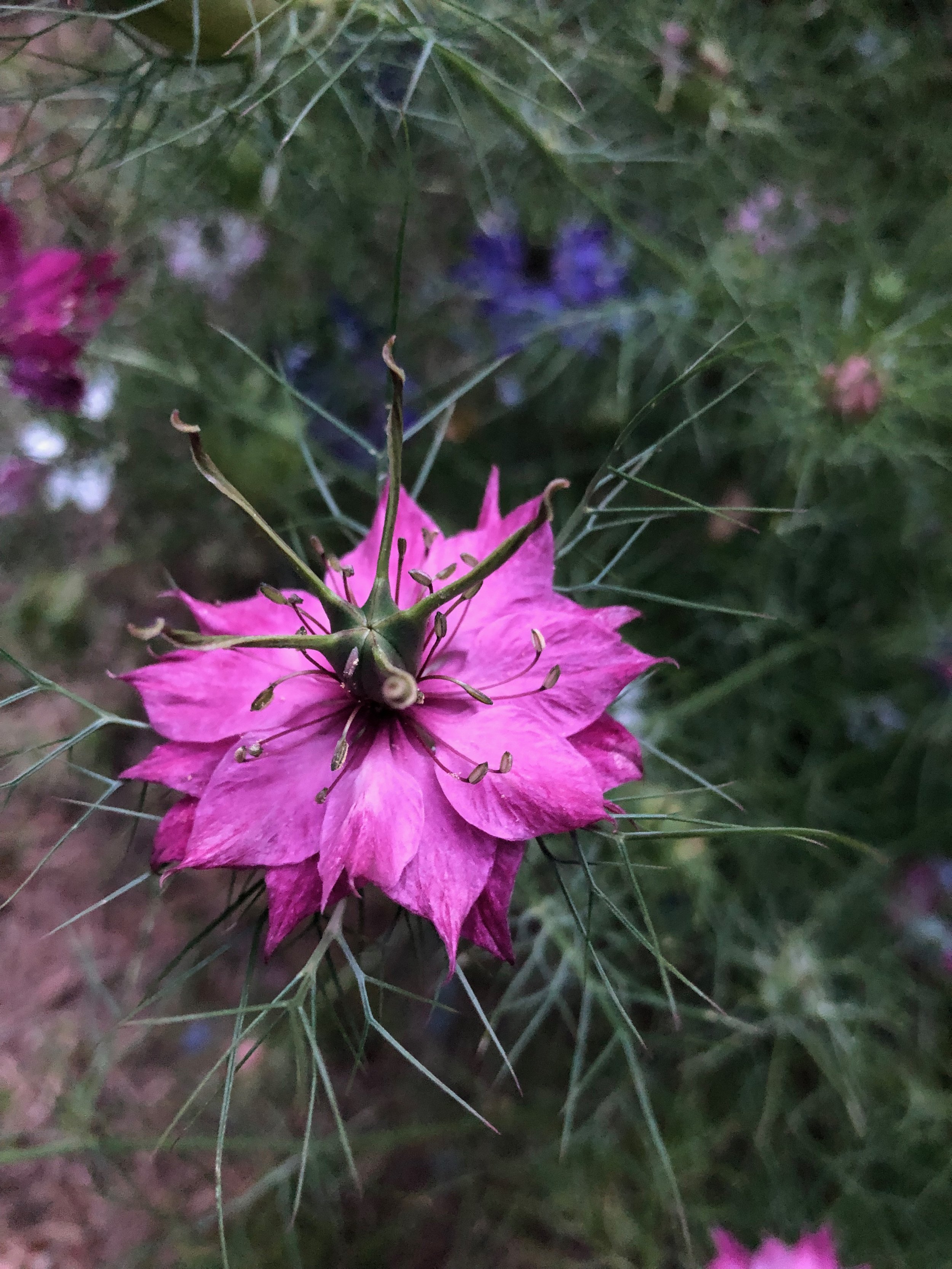 Image 1 of 4
Image 1 of 4

 Image 2 of 4
Image 2 of 4

 Image 3 of 4
Image 3 of 4

 Image 4 of 4
Image 4 of 4





Nigella (Love-in-the-Mist) Seeds
Nigella (Nigella demascena)
Description:
Nigella (Nigella damascena), belonging to the Ranunculaceae family, is an annual flowering plant admired for its delicate, intricate flowers and interesting seed pods. It is native to the Mediterranean (southern Europe), North Africa and Southwest Asia. Nigella is a herbaceous plant with finely divided, fern-like leaves that give it an airy appearance. It produces solitary flowers atop slender stems. After flowering, unique seed pods develop, which are spherical and covered with spiky bracts, encapsulating the edible, spiced seeds. These seed pods add further ornamental interest to the plant.
Growing Conditions:
Climate: cool-temperate; adaptable to a wide range of climates.
Position: full sun to partial shade with at least 4 to 6 hours of direct sunlight.
Soil: well-draining, moderately fertile soil although can adapt to sandy, loamy, or clay soil; ideal soil pH should be neutral to slightly alkaline, ranging from 6.0 to 7.5.
Water: moderate water needs; water the plant regularly to keep the soil evenly moist but not waterlogged; relatively drought-tolerant once established.
Spacing: space the plants approximately 6 to 12 inches (15 to 30cm) apart, depending on the specific variety and desired density. Personally, I don’t bother to thin out seedlings if they are direct sown or self-seeded.
Propagation: sow the seeds directly into the garden bed or seed flats/pots in early spring after the last frost date or in autumn. Nigella readily self-seeds, so allow some seed pods to mature and drop seeds for natural reseeding.
Harvest: harvest the seed pods when they have matured and turned brown. The pods should be dry and rattling when gently shaken. Hang the stems upside down in a cool, dry location to allow the seed pods to fully dry. Once dry, gently crush the pods to release the small black seeds.
~100 seeds per pack
Nigella (Nigella demascena)
Description:
Nigella (Nigella damascena), belonging to the Ranunculaceae family, is an annual flowering plant admired for its delicate, intricate flowers and interesting seed pods. It is native to the Mediterranean (southern Europe), North Africa and Southwest Asia. Nigella is a herbaceous plant with finely divided, fern-like leaves that give it an airy appearance. It produces solitary flowers atop slender stems. After flowering, unique seed pods develop, which are spherical and covered with spiky bracts, encapsulating the edible, spiced seeds. These seed pods add further ornamental interest to the plant.
Growing Conditions:
Climate: cool-temperate; adaptable to a wide range of climates.
Position: full sun to partial shade with at least 4 to 6 hours of direct sunlight.
Soil: well-draining, moderately fertile soil although can adapt to sandy, loamy, or clay soil; ideal soil pH should be neutral to slightly alkaline, ranging from 6.0 to 7.5.
Water: moderate water needs; water the plant regularly to keep the soil evenly moist but not waterlogged; relatively drought-tolerant once established.
Spacing: space the plants approximately 6 to 12 inches (15 to 30cm) apart, depending on the specific variety and desired density. Personally, I don’t bother to thin out seedlings if they are direct sown or self-seeded.
Propagation: sow the seeds directly into the garden bed or seed flats/pots in early spring after the last frost date or in autumn. Nigella readily self-seeds, so allow some seed pods to mature and drop seeds for natural reseeding.
Harvest: harvest the seed pods when they have matured and turned brown. The pods should be dry and rattling when gently shaken. Hang the stems upside down in a cool, dry location to allow the seed pods to fully dry. Once dry, gently crush the pods to release the small black seeds.
~100 seeds per pack
Nigella (Nigella demascena)
Description:
Nigella (Nigella damascena), belonging to the Ranunculaceae family, is an annual flowering plant admired for its delicate, intricate flowers and interesting seed pods. It is native to the Mediterranean (southern Europe), North Africa and Southwest Asia. Nigella is a herbaceous plant with finely divided, fern-like leaves that give it an airy appearance. It produces solitary flowers atop slender stems. After flowering, unique seed pods develop, which are spherical and covered with spiky bracts, encapsulating the edible, spiced seeds. These seed pods add further ornamental interest to the plant.
Growing Conditions:
Climate: cool-temperate; adaptable to a wide range of climates.
Position: full sun to partial shade with at least 4 to 6 hours of direct sunlight.
Soil: well-draining, moderately fertile soil although can adapt to sandy, loamy, or clay soil; ideal soil pH should be neutral to slightly alkaline, ranging from 6.0 to 7.5.
Water: moderate water needs; water the plant regularly to keep the soil evenly moist but not waterlogged; relatively drought-tolerant once established.
Spacing: space the plants approximately 6 to 12 inches (15 to 30cm) apart, depending on the specific variety and desired density. Personally, I don’t bother to thin out seedlings if they are direct sown or self-seeded.
Propagation: sow the seeds directly into the garden bed or seed flats/pots in early spring after the last frost date or in autumn. Nigella readily self-seeds, so allow some seed pods to mature and drop seeds for natural reseeding.
Harvest: harvest the seed pods when they have matured and turned brown. The pods should be dry and rattling when gently shaken. Hang the stems upside down in a cool, dry location to allow the seed pods to fully dry. Once dry, gently crush the pods to release the small black seeds.
~100 seeds per pack